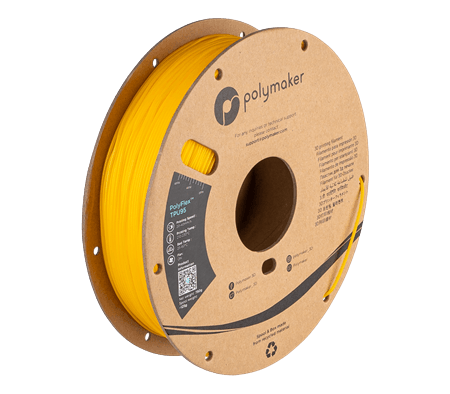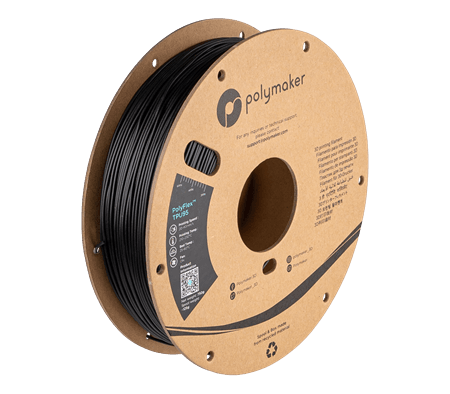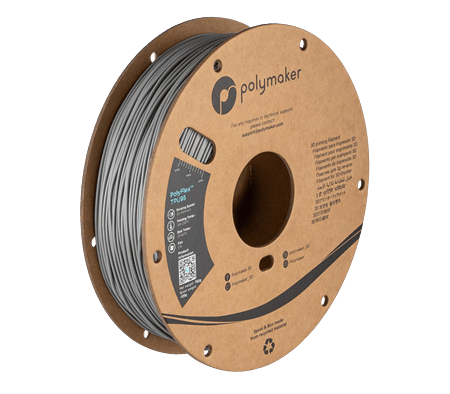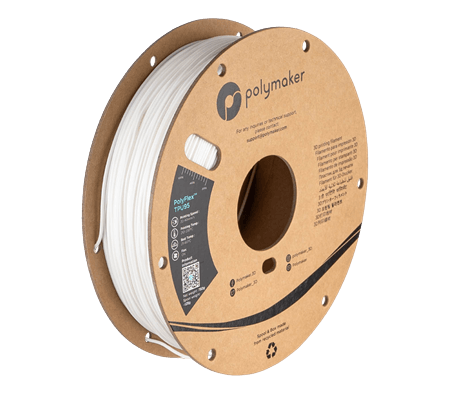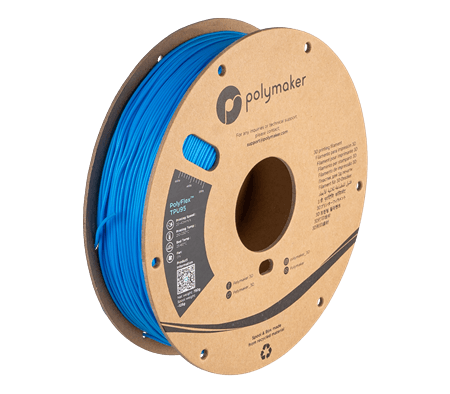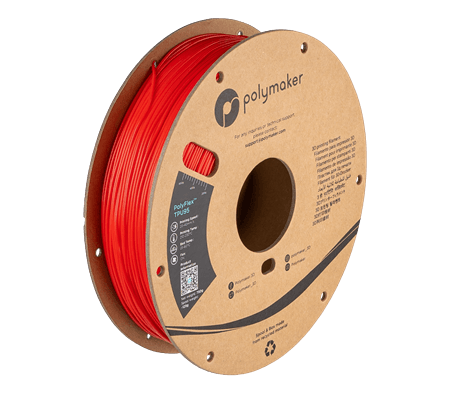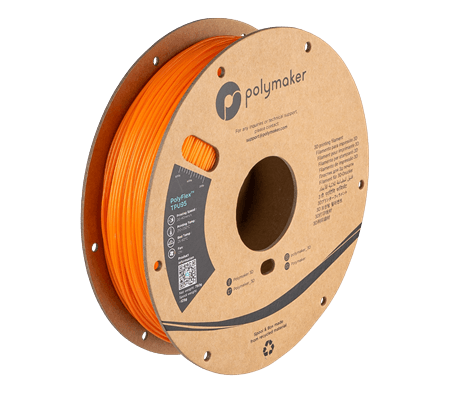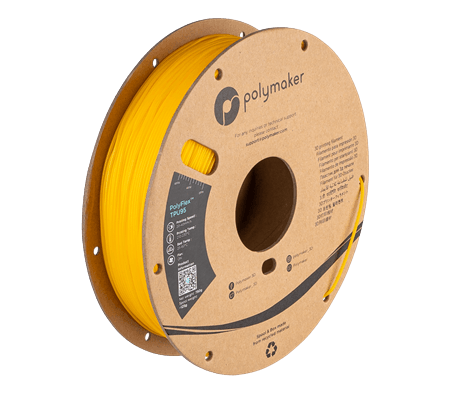Polymaker
Polymaker PolyFlex TPU95 750g 1.75mm Filament
Polymaker PolyFlex TPU95 750g 1.75mm Filament
Low stock: 2 left
Couldn't load pickup availability
Flexible PolyFlex™ TPU featuring 95A Shore hardness.
- Flexible Polymaker TPU.
- Shore hardness of 95A.
- Exceptional durability, impact resistance & shape memory.
- Elongation at break over 330%.
- Formulated for wide printer compatibility.
- Consistent colour and tolerance (1.75mm diameter +/- 0.03mm)

PolyFlex™ is a family of high-quality flexible materials. It provides the perfect solution for applications where high flexibility and durability are required. PolyFlex™ TPU95 is a thermoplastic polyurethane (TPU) based filament specifically engineered to work on most desktop 3D printers. It has a shore hardness of 95A and can stretch more than 3 times its original length.
Features
Flexible & Durable - PolyFlex™ TPU95 features a “Shore A” hardness of 95A, producing flexible parts with excellent durability. Thanks to 3D printing, a model can also be made
more or less flexible depending on its design and infill.
Fun & Functional - The flexible properties of PolyFlex™ TPU95 open up a new dimension of what one can do with desktop 3D printers. Wearable’s, hobby parts, prosthetics, custom gaskets, jigs & fixtures; with PolyFlex™ TPU95 the possibilities are endless.
Wear & Tear Resistance - Featuring an elongation at break result of 330% combined with excellent wear, tear and impact resistance, PolyFlex™ TPU95 is commonly used for a variety of demanding applications.
Formulated For 3D Printing - Flexible filaments are known to be more difficult to work with when compared to rigid filaments. PolyFlex™ TPU95 balances flexibility and usability to provide a unique 3D printing filament that is compatible with a wider range of desktop FDM/FFF 3D printers.
Uncompromised Quality - Polymakers leading quality control process and rigorous inhouse testing ensure reliable printing and consistency across spools and batches.
Printing Settings
| Nozzle Temperature | 210°C - 230°C |
|---|---|
| Build Plate Temperature | 25˚C - 60˚C |
| Build Surface Material | Works well with most build surfaces i.e Glass BuildTak® etc |
| Build Surface Treatment | None typically required, can apply PVA glue or Magigoo Flex to the build surface |
| Cooling Fan | ON |
| Printing Speed | 20 mm/s - 40 mm/s |
| Recommended Support Material | Dual Extrusion: PolyDissolve™ S1 (Dissolve in tap water) |
The above are printing recommendations based on 0.4 mm nozzle. Success with smaller nozzles are more experimental with flexibles due to higher back-pressure in the nozzle. Larger nozzle sizes can reduce back-pressure in the nozzle but depending on the layer width & layer height we recommend higher extrusion temperatures or slower printing speeds.
For other tips printing PolyFlex™ TPU95, contact us!
Storage & Drying:
All plastics are hygroscopic meaning they absorb moisture from the air which can affect printing quality and strength of printed parts. How quickly this absorption occurs depends on the material and your environment. PolyFlex™ TPU95 filaments are dried and packaged in a vacuum sealed bag with desiccant to ensure the best printing quality. When not in use PolyFlex™ TPU95 should be stored away from sunlight and sealed in the packaged resealable bag.
Although filaments can be dried, drying will speed up the aging process of the plastic. Preventing the filament from absorbing moisture in the first place is the best solution to keep your filament working to its maximum potential. For long term storage we highly recommend storing in a sealed container with dry desiccant that reduces the relative humidity to 10-20% RH.
In-house we manage our filaments with Polymakers PolyDryer™ which keep offers best-in-class sealing to protect filaments from absorbing moisture
If you hear popping sounds and notice that the surface quality of your print is uneven or the colour is not consistent, this is a likely indicator that the filament has absorbed too much moisture. Spools of PolyFlex™ TPU95 can be dried with Polymaker PolyDryer™ using power level 2. Alternatively if you have a convection oven that is accurate at low temperatures, users can dry filament in a preheated convection oven at 70˚C for up to 8 hours. Results may vary depending on the accuracy of your oven so please be conservative. For more information about filament drying please read our user guide.
Specification
| Net Weight | 750g |
|---|---|
| Material Type | TPU (Thermoplastic Polyurethane) |
| Density | 1.20 - 1.24 (g/cm3 at 21.5˚C) |
| Colour | Black |
Technical Data
All testing specimens were printed under the following conditions: Nozzle Temperature = 225˚C, printing speed = 30 mm/s, build plate temperature = 45˚C, infil = 100%
All specimens were conditioned at room temperature for 24h prior to testing.
MECHANICAL PROPERTIES
| Value | Testing Method | |
| 100% modulus (X-Y) | 9.4 ± 0.3 MPa | ISO 527, GB/T 1040 |
| Tensile strength (X-Y) | 29 ± 2.8 MPa | ISO 527, GB/T 1040 |
| Elongation at break (X-Y) | 330.1 ± 14.9 % | ISO 527, GB/T 1040 |
| Shore hardness | 95A | ISO 7619 GB/T 31 |
We have full safety data sheets and technical data sheets for PolyFlex™ TPU95 and all other Polymaker products. Contact us to enquire!
The typical values presented in Polymakers data sheet are intended for reference and comparison purposes only. Due to the nature of 3D printing they should not be used for design specifications or quality control purposes.
Compatibility
PolyFlex™ TPU95 has been engineered with compatibility in mind to print excellently on a wide range of 3D printers. With some extruder set ups a larger nozzle (0.5mm or 0.6mm) may be recommended to reduce pressure in the nozzle and improve extrusion consistency.
Flexible filaments tend to have more specific feeding requirements so it is recommended to make sure your filament guide system is smooth and with minimal bends to reduce drag. Any unnecessary drag can result in under extrusion so we also recommend bypassing features that apply pressure to the filament such as mechanical filament detection switches. or users who operate a 3D printer with an optical filament detection switch, please note that optical filament detection switches will not detect clear, transparent or semi-translucent filaments. On these machines the optical detection switch will need to be disabled to print with such colours.
Of course with thousands of unique 3d printer models on the market, we can't guarantee each filament type will work with every 3D printer. Slicer experience and setting adjustment is always required to get the most out of a material. Before jumping into an ambitious project we always recommend printing some known calibration tests to build or make adjustments to the filament profile.
FAQ
Q: Can PolyFlex™ TPU95 be printed at large scales without warping?
A: PolyFlex™ TPU95 offers excellent dimensional stability and can certainly be printed at large scales without warping. Please note while we have never experienced warping with PolyFlex™ TPU95; we recommend a consistent room temperature as printing in a cold environment or with poor first layer adhesion can cause any material to warp.
Q: What support materials can I use with this product?
A: Polymaker’s PolyDissolve™ S1 filament is the recommended support filament for PolyFlex™ TPU95. If your 3D printer is not equipped for multi-material, self-support can be used however support removal will be difficult.
Don't know where to start? Or which filament will suit your application? We have a broad range of support options including telephone support. Contact us today!
| Filament | |
| Diameter | 1.75mm |
| Spool Weight | 750g |
TPU (Thermoplastic polyurethane) is a flexible 3D printing material. One way to indicate the flexibility and softness of the filament is by looking at the Shore hardness. PolyFlex™ TPU95 displays a shore hardness of 95A, a hardness carefully chosen which allows it to not stretch excessively when pulled by the extruder, improving overall printer compatibility.
- Excellent flexibility and durability.
- Excellent impact resistance and resistance to wear.
- High elongation at break up to 330%.
- Minimal printing requirements when compared to other flexible filaments.
- Exhibits excellent dimensional stability.

PolyFlex™ TPU95 is a popular material among both hobbyists and professionals interested in 3D printing flexible parts. It's commonly used by hobbyists to 3D print shock absorbent camera and drone parts, the footwear industry to print upper shoes, soles or insoles, professionals to create flexible jigs and fixtures, and is commonly used to print custom gaskets.
The soft and flexible nature of PolyFlex™ TPU95 continues to provide endless possibilities for creatives and engineers alike.

3D printed primer pump, printed in Black PolyFlex™ TPU95
Design considerations in combination with different infil densities and infil patterns can be used to control the overall flexibility of the final print. Rectilinear and Grid infil patterns are some of the most popular choices for general purpose projects and readily available in most slicers. Advanced three dimensional infil patterns such as Cross3D and Gyroid offer some benefits in the form of uniform flexibility. Using a moderate infil with structural infil types such as Hexagon and Triangles can increase part rigidity, enabling the production of jigs and impact-resistant parts which prioritise durability rather than flexibility.
PolyFlex™ TPU95 offers fantastic printability compared to many other TPU grades and demonstrates excellent dimensional stability, enabling users to print large flexible parts without warping. An enclosure isn't required however may be beneficial in particularly cold or drafty environments. PolyFlex™ TPU95 prints with excellent inter-layer adhesion and it's compatibility with specialised support materials, enabling users with a dual extrusion 3D printer the ability to complex structures and geometry.

PolyDissolve™ S1 is a dedicated support material engineered for printing water dissolvable supports with perfect interfacing and improved part surface quality. PolyDissolve™ S1 offers excellent compatible with a wide range of material types and Polymaker filaments including PolyFlex™ TPU95.
Materials
Materials
PLA - This solid filament is used to make models that are a refined representation with rigid properties.
TPU - This flexible filament holds the shape of the model and can with stand being twisted and squashed to survive the field environment.
Shipping
Shipping
Free standard shipping and Express for free orders over $300 calculated at the checkout.
All items are shipped from Townsville, QLD.
Shipping World Wide - coming soon.
Care Instructions
Care Instructions
PLA
Temperature:
Keep it cool! PLA starts to soften at around 60°C (140°F), so avoid placing it near heat sources or leaving it in hot cars.
Sunlight:
Prolonged direct sunlight can cause fading and potential deformation. Try to keep it out of long sun exposures.
Cleaning:
Gently wash with warm water and a bit of mild soap using a soft cloth. No harsh scrubbing, please!
Handling:
Handle with care—avoid excessive bending or dropping it, as PLA is rigid and can crack or break.
Storage:
Store in a cool, dry place to maintain its shape and longevity.
TPU
Temperature:
TPU is built to be flexible, but still avoid extreme or prolonged heat. It’s more resilient than PLA, but unnecessary heat can still degrade it over time.
Sunlight:
Try not to leave TPU items in direct sunlight for too long, as UV rays can fade the colors and slowly affect the material quality.
Cleaning:
Just like PLA, a quick clean with warm water and mild soap works great. Use a soft cloth and don’t be too rough.
Handling:
Enjoy its flexibility! However, even though TPU can bend, continuous stretching or heavy impacts might wear it out faster.
Storage:
Keep it in a cool, dry spot away from harsh elements to maintain its flexibility and appearance.
Share
